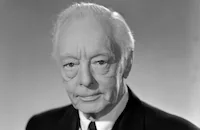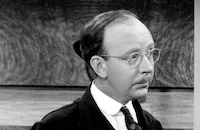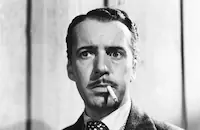I Wanted Wings
Brief Synopsis
Cast & Crew
Mitchell Leisen
Ray Milland
William Holden
Wayne Morris
Brian Donlevy
Constance Moore
Photos & Videos
Film Details
Technical Specs

Synopsis
Eighteen Army Air Corps bombers head toward Los Angeles to engage in a simulated air raid. At the completion of the air raid, one of the bombers crashes in the desert and the body of a woman is found in the wreckage. A military court-martial follows and pilot Jefferson Young III is charged with disobedience and admitting an unauthorized passenger onto a military plane. When Jeff pleads guilty, the court considers his military history: Jeff, heir to a New York fortune, garage mechanic Al Ludlow and football hero Tom Cassidy meet when they bunk together while training for the U.S. Army Air Corps at Randolph Field in Texas. Jeff and Al develop a strong friendship as they encourage each other through training and boost their self-confidence. When Jeff meets Al's old flame, nightclub singer Sally Vaughn, he is unaware of his friend's previous relationship with her, and Sally decides to win the heir for herself. Jeff is in love with photographer Carolyn Bartlett, who is away on a photo-shoot. However, after failing to pull a buddy from a flaming wreck, Jeff loses his confidence and visits Sally in a drunken stupor. Al saves Jeff from Sally's greedy clutches, and Jeff later reunites with Carolyn at a dance, after he apparently firmly rejects Sally. The next training session takes the three friends to Kelly Field, also in Texas, and Al is appointed senior cadet captain in charge of the group. They lose Tom when he is killed while attempting some daredevil maneuvers and his plane crashes. Al is dismissed from the Corps for allowing the stunts and his lifetime dream of flying is destroyed. Sally announces that she has gotten "in trouble" by Jeff, who has continued to see her because she threatened to reveal their affair and ruin his military career. Al, who has always loved Sally, now marries her to save Jeff's career. Carolyn leaves Jeff after learning of his deceit and of Al's self-sacrifice. Jeff's pride at graduating from final training is compromised by the loss of his friends. Six months later in Kansas City, Sally leaves Al when, upon revealing that she lied about her pregnancy, Al admits that he knew all along and Sally mistakenly assumes that he does not love her. Sometime later at March Field, Jeff prepares a bomber for war game maneuvers and discovers that Al is the crew chief aboard the plane. Their flight instructor and commander, Mercer, who has guided their careers in the Corps, promises to get Al reinstated. Sally appears unexpectedly and begs Al for help because she is wanted for murder. Al gives her money to leave for Los Angeles, but Sally panics when she sees army officers coming into the hangar, and unknown to Al, hides in the cargo bay of the bomber. After they successfully complete their war games over a blacked-out Los Angeles, Mercer orders Jeff to return to the desert to test their new emergency flares. Al discovers a terrified Sally when he goes to get the flares and as she struggles with him, a flare ignites. While attempting to get rid of the flare, Mercer is injured when it explodes before leaving the bomb bay doors, and Al leaps to save him. They float to safety with Al's parachute, and Jeff makes a dangerous night landing to help them. After discovering that Mercer needs immediate medical help, Jeff attempts a takeoff in the dark, despite Mercer's orders to the contrary, but crash-lands the plane. Sally is killed in the crash and Jeff takes full responsibility for the accident and for her presence on the plane. At Jeff's court-martial, Al reveals the truth of his involvement and Jeff is found innocent of all charges. Mercer fully recovers, Al is sent to Kelly Field to complete his training and Jeff reunites with Carolyn.

Director

Mitchell Leisen
Cast

Ray Milland

William Holden

Wayne Morris

Brian Donlevy
Constance Moore

Veronica Lake

Harry Davenport
Phil Brown
Edward Fielding
Willard Robertson

Richard Lane

Addison Richards

Hobart Cavanaugh
Douglas Aylesworth
John Trent
Archie Twitchell
Richard Webb
John Hiestand

Harlan Warde
Lane Chandler
Jack Chapin

Charles Drake

Alan Hale Jr.
Renny Mcevoy
Arthur Gardner
Lane Allan
Jack Shea
Frank O'connor

Michael Gale

James Millican
Emory Johnson
Russ Clark
George Turner
Hal Brazeale
Warren Ashe
Charles A. Hughes
George Lollier
John Sylvester
John Mcavoy

Boyd Irwin
Ralph Emerson
Anthony Nace
Jack Luden
Gilbert Wilson
George Eldredge
Gaylord Pendleton
John Beach
Frank H. Larue
Henry Hall
Gladden M. James
Jimmy Lucas
Lee Shumway
Charles Hamilton
Keith Richards
John Ellis
Rod Cameron

Phillip Terry
Edward Peil Sr.
James Farley
Lester Dorr
Charles D. Waldron
Crew
Bob Alford
Milward Anderson
Robert Axman
Jim Barton
Hugh Bennett
Clayton Brackett
Francis Burgess
Frank Caffey
Art Camp
Elmer Cannon
Nesta Charles
Edward Churchill
Capt. William J. Clinch
Carl Coleman
R. D. Cook
Robert Riley Crutcher
Richard Cutter
John J. Daheim
Dana Dale
Kenneth Deland
Jean Dixon
Hans Dreier
Andy Durkus
George Dutton
Elmer Dyer
Farciot Edouart
Don English
Merle Enz
Michael Fessier
Mrs. Frampton
Curtis Gourlay
James Grant
Lieut. Fred Gray
Eleanore Griffin
Loyal Griggs
Hazel Hagerty
George O. Hamer
M. G. Harris
Sig Herzig
James Hinman
Warren Hoag
Harry Hogan
Hayden Hohstadt
Arthur Hornblow Jr.
Jimmie Hosler
Arthur Jacobson
Gordon Jennings
Leonard Jones
Frank Kies
Charles Klein
Norman Lacey
Arthur A. Lane
Ernest Laszlo
Al Latta
Lieut. Beirne Lay Jr.
Lieut. Beirne Lay Jr.
Sam Levine
Harry Lewis
C. Ken Lobben
J. C. Love
Richard Maibaum
Paul Mantz
Russell Matthews
John Meehan
Andrew Mendoza
Joe Mendoza
Gene Merritt
Louis Mesenkop
Curtis Mick
Thomas Morris
Ray Moyer
Basil Mulvaney
Roy Newman
William Newman
1st Lieut. William P. Nuckols
Richard Olson
Edward Overstreet
Hugh G. Payne
Harry Perry
Otto Pierce
Bernard Ponedel
Lee Price
Lyle Ratican
James Roe
L. B. Rogers
Robert Rogers
Robert Rogers
Arthur Rosson
Charles Russell
Schuyler Sanford
Byron Seawright
Charles Sickler
John Smirch
Kenneth Smith
Lavaughn Speer
Ed C. Sullivan
Walter E. Sullivan
Frank Thayer
Leo Tover
Fred True
Robert Usher
Russell Walters
Ned Washington
Frank Wead
Paul Whitcomb
Ed White
M. C. White
Stanley Williams
John P. Wilson
Dewey Wrigley
Dan Wyler
Victor Young
Victor Young

Photo Collections
Film Details
Technical Specs

Award Wins
Best Special Effects
Quotes
Trivia
While 'Lake, Veronica' and Richard Webb (I) were rehearsing a scene, director Mitchell Leisen filmed a scene which included this rehearsal for his later film Hold Back the Dawn (1941).
Ray Milland was in a plane which was being test flown for a shot in the film. Sensing an opportunity, Milland (an amateur skydiver) was about to jump out of the plane to parachute for free, when the pilot informed him of engine trouble. Upon returning to the ground, Milland related the tale to the horrified film crew, one of whom was the costumer who informed him that the "parachute" on his back was merely a non-functional prop.
Notes
The following written statement appears in the opening credits: "This production was actually filmed at Randolph, Kelly and March Fields. The splendid collaboration of the United States Army Air Corps is gratefully acknowledged." This written dedication appears after the film's opening credits: "Birthplace of man's wings, America today watches her skies with great concern, for in these skies of peace the nation is building the upper battlement of its defense. To the officers and men of the United States Army Air Corps who climb on strong wings to man these high ramparts, and to the young men of America who will take their places beside them, this motion picture is dedicated." Randolph Field and Kelly Field near San Antonio, TX were U.S. Air Force bases; Randolph Field was the site of basic flight training for cadets and Kelly Field was the site of the Air Corps Advanced Flying School until 1942. March Field in Riverside, CA, was then known as the home of the B-17 Flying Fortress.
According to news items in Hollywood Reporter, J. Theodore Reed was the first director assigned to I Wanted Wings; however, he resigned as director on September 7, 1940 after pre-production and two weeks of shooting on location in San Antonio, TX. Mitchell Leisen took over direction after Reed's departure. No contemporary information has been found to confirm the reason for Reed's departure, but modern sources indicate that his work was unsatisfactory to Paramount executives, who then called Leisen in to complete the film. Leisen, in a modern interview, states that he scrapped all of Reed's footage and started fresh. Leisen was originally scheduled to direct Paramount's New York Town (see below), and as a result of his shift to I Wanted Wings, Charles Vidor took over direction of that film. In July 1940, Paramount hired Arthur Rosson as second unit director, and the interoffice Paramount communication regarding his employment reads: "We desire to employ Arthur Rosson as a second unit director....Mr. Rosson has worked here a number of times with Mr. [Cecil B.] DeMille and I think he would work for us....The work will be just as difficult, but the screaming will not be quite so loud."
The following information was derived from the Paramount Collection at the AMPAS Library: Author Captain John H. Fite was then Chief of the Motion Picture Unit Technical Data Branch of the War Department. Fite also reviewed and selected the footage from the U.S. Army film Wings of the Army that was used in this film. According to a October 4, 1939 letter, author Beirne Lay, Jr. was involved from the very beginning of the project with developing the screen story and getting the cooperation of the Air Corps. On June 29, 1940, Paramount received official notification from the War Department Motion Picture Board of Review that the script was deemed acceptable dependent on minor changes, and that Paramount would receive the full cooperation of the Air Corps as long as the production did not interfere with regular military procedure. Writers Robert Riley Crutcher and Michael Fessier were hired to work on the script. Although their initial agreement with Paramount was for them to receive screen credit, neither name appears on the film. A July 29, 1940 agreement notes that screenwriter Sig Herzig was hired to "sharpen characterizations through dialogue and add humor to the script."
The MPAA/PCA files at the AMPAS Library indicate that Joseph I. Breen, director of the PCA, was concerned that there be no indication that the characters "Sally" and "Jeff" have an "illicit sex affair." In an July 8, 1940 letter, Paramount executive Luigi Luraschi responded that although the "tartiness" in Sally's character will be properly cleaned up," producer Arthur Hornblow, Jr. insisted that "the device she resorts to-that of having a baby," remains because only a "strong motivation" of that nature would ensure the credibility of the story. On August 29, 1940, Breen responded that "with regard to Sally's remark, 'I'm in trouble,'" it was only acceptable to use this phrase as a "device on Sally's part to frighten Jeff, it afterwards being proved to be a lie...."
Although this film was billed as Veronica Lake's feature film debut, she appeared in several films between 1939 and 1940 under the name Constance Keane. Her name was changed for I Wanted Wings. According to a Hollywood Reporter news item, Paramount filmed a "personality trailer" to be screened in theaters to "introduce Veronica Lake to the public." The trailer was produced by Lou Harris and narrated by Y. Frank Freeman. According to modern sources, her voice was dubbed for the singing sequence. Information in the Paramount Collection reveals that Hedda Hopper was cast in the film to play "Jeff Young's" mother, but left Randolph Field unexpectedly during production to attend a radio broadcast in Los Angeles. The information implied that her scenes May not have been completed before she left. Hopper did not appear in the viewed print, nor was she mentioned in reviews.
Hollywood Reporter news items note that the original script for I Wanted Wings was written with Rita Hayworth in mind; however, Columbia refused to loan her to Paramount for the part of "Sally" because they deemed the role inappropriate for Hayworth, even after Paramount ostensibly made script changes. News items indicate that Lana Turner and Susan Hayward were also considered for lead roles, and information in the Paramount Collection reveals that the studio was considering Patricia Morison as well. A Hollywood Reporter news item reported that dancer Mary Cassiday was cast in the film; however, her appearance in the film is doubtful. The following cast members and roles were listed in an early Paramount billing sheet, but May not have been in the final print: Herbert Rawlinson (Mr. Young); Harlan Warde (Cadet); and Bob Ireland (Bombardier). Because of potential problems with scheduling, Paramount considered casting John Howard rather than Ray Milland, according to information in the Paramount Collection. A Hollywood Reporter news item notes that John Trent, who had been a professional pilot prior to his acting career, was hired by the North American Aircraft Company of Inglewood, CA, following his appearance in this film to fly planes from California to Canada for shipment to Great Britain. This film marks the feature film debuts of Alan Hale, Jr. and Renny McEvoy, son of humorist J. P. McEvoy.
I Wanted Wings benefitted from the Army's full cooperation and from author Beirne Lay, Jr.'s firsthand knowledge of military flight training. According to modern sources, producer Arthur Hornblow Jr. timed the filming of the training sequences to coincide with the arrival of new cadets at Randolph Field, TX, and Army planes were made available to Paramount. The educational Film and Radio Discussion Guide indicated that 1,050 cadets, 540 officer and instructors and 2,543 enlisted men provided a background for the filmmakers and an estimated $25,000,000 worth of flying equipment was made available for filming. The Guide noted that this film offered the public their first glimpse inside a B-17 Flying Fortress while in flight. Hollywood Reporter news items and the Guide discussed some of the unique filming techniques for the aerial sequences, for which unit director Arthur Rosson directed the scenes from the control tower by three-way radio connected to stunt pilot Paul Mantz and Lieutenant Fred Gray, head of the flight formation squadron and an Air Corps flight instructor. Aerial cameraman Elmer Dyer called the shots. Modern sources note that the invention of the triple-head process projector by Farciot Edouart, Gordon Jennings and Louis Mesenkop, for which they won an Academy Award for Special Effects in this film, added cinematic verity to certain flight scenes.
According to information in the Paramount Collection, I Wanted Wings cost over $1,000,000 to produce and came in $262,454.87 over budget. A February 1941 Hollywood Reporter news item noted that the footage was cut from 15,000 ft. to the release footage of 13,962 ft., which was its length when approved by the PCA. However, the film was approved by the New York State Censor board at 12,825 ft. Reviewers who quoted the running time as 130-131 min. saw a preview of the roadshow release, which was a long version to be shown with an intermission. It is not clear if the "long" version was 15,000 ft. or 13,962 ft.. Paramount planned to release the film for regular bookings in a shorter version. The Exhibitor later noted that the film retained its "original length" for the regular release. News items further note that a special preview screening was planned for Randolph Field, TX, which would be preceded by a full Army Air Corps show displaying 300 war planes, described as "the biggest single display of its kind ever held in the southwest."
I Wanted Wings received many accolades from reviewers chiefly for its technical merits and as a "vastly exciting motion picture and a dependable inspiration to the youth of the land" (New York Times). Hollywood Reporter acknowledged "I Wanted Wings is propaganda, yes-and a vibrant challenge. First feature to reach the screens under the industry's cooperation with national defense, this is stuff to make the dictator nations shudder under its impact; it is actual and factual presentation of America's strength in human valor and material." While Hollywood Reporter called Veronica Lake's debut "glittering," the New York Times review noted that she "manages to show little more than a talent for wearing low-cut gowns." However, most reviews praised all the performances.
A scene from I Wanted Wings was reshot by Mitchell Leisen specifically to appear in a sequence for the 1941 Paramount film Hold Back the Dawn, in which the character played by Charles Boyer visits Paramount studios. In a modern interview, Leisen stated that his assistant director was Chico Alonso. Ray Milland and William Holden reprised their roles in a Lux Radio Theatre broadcast on March 30, 1942, co-starring Veronica Lake in her Lux debut.












